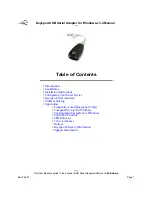
10
Upper Panel
The upper
panel
shows all local HomePlug devices connected to the
computer’s NIC (Network Interface Card). In most cases, only one device will
be seen. In situations where there are more than one local device being
connected, such as a USB or an Ethernet adapter, the user can select the local
device by clicking on it and then click the “
Connect
”
to connect to the selected
device
. Once connected to the local device, the utility will automatically scan
the power line periodically for any other HomePlug devices.
Lower Panel
The
lower panel
displays all the HomePlug remote devices, discovered on the
current logical network. In the top of the table, you can see the total number of
remote devices connected on the same network, the Network type (Public or
Private) of the network and the scanning status.
Device Name:
shows the default device name, which may be user re-defined.
A user can change the name by either clicking on the
“Rename” button
or by
clicking on the name and editing in-place.
An icon is usually shown with the name. A color distinction in icons is made
between HomePlug 1.0, HomePlug 1.0 Turbo and HomePlug 1.1 devices. By
default, the icon is always accompanied by a device name.
Password:
by default the password column is blank and
‘Enter Password’
button
can be used to enter it.
To set the Password of the device (it is required when creating a private
network), first select the device by clicking on its name in the lower panel and
then click on the “Enter Password”. A dialog box will appear. The selected
device name is shown above the password field and the password can be
verified by hitting the OK button. The Password field accepts the Device
password in any case formats, with or without dashed between them.
Note 1:
The device must be present on the power line (plugged in) in order for
the password to be confirmed and added to the network. If the device could not
be located, a warning message will be shown.
Note 2:
Please find the password of the HomePlug device in the rear panel.












































